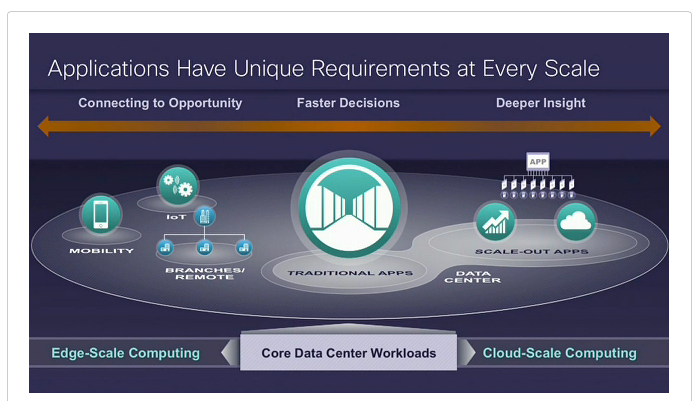Cisco Gets The Lead Out With ‘Fast IT’

Cisco Systems wants to ride the data-driven wave dubbed the Internet of Everything to take its Unified Computing System architecture from the datacenter to the networked sensors that the company estimates will collect 40 percent of data by 2020.
The server and switching giant laid out its "fast IT" strategy – a blueprint that seeks to make Cisco the plumbers of the IoE – during a presentation in New York City today. The networking company also announced an expansion of its UCS partner network with the integration of Red Hat's Enterprise Linux OpenStack platform.
Padmasree Warrior, Cisco's chief technology and strategy officer, attempted to flesh out the concept of an Internet of Everything and describe the "foundational elements" of what the company believes is a multi-trillion-dollar opportunity over the next decade. As brick and mortar business operations move to the cloud, the emerging IoE includes "networked connections of people, process, data and things," Warrior explained.
All this is creating a "new mandate for IT" as, for example, demand grows for enterprise applications on mobile platforms. Cisco response is a "fast IT" strategy underpinned by an evolving "application-centric infrastructure" that is being fine-tuned to move computing power closer to the sensors generating all that data.
Hence, the company is seeking to move beyond core datacenter workloads as its shifts to both cloud-scale computing on one end and edge-scale computing on the other as data-driven applications evolve. In other words, company executives said it wants to "power applications at every scale."
Along with the need for IT speed, the Internet of Everything is generating new sources of computing demand, asserted Paul Perez, Cisco's UCS general manager. Therefore, the company's strategy involves "connecting computing as close as possible to the data," Perez added.
As for IoE plumbing, Cisco also launched its UCS M-Series modular servers today that allow it to take on hyperscale workloads and the custom server makers who tend to build the machines that run them.
Cisco's M-Series servers would underpin the cloud-scale end of its new strategy designed to shift computing power along with storage and networking from the datacenter to the cloud. The company claims adoption of its model can help reduce customers' capital expenditures by 29 percent.
If it's true, as Cisco insists, that "applications have unique requirements at every scale," then the shift to cloud-scale computing also offers the promise of "scaling out apps" in a way datacenters could not when deploying traditional applications. One method for scaling apps like Hadoop will be delivering them via a USC "director" using container technology, Cisco said.
Meanwhile, Cisco's partnership with Red Hat aims to streamline deployment of OpenStack-based private clouds along with providing an "on-ramp" to Cisco's "Intercloud" platform designed to link private, public and hybrid clouds, the partners said.
Cisco has also partnered with Major League Baseball's Advanced Media unit to stream game stats and other services to fans. Warrior held up professional baseball's demand for more platforms to deliver more apps as a classic example of Cisco's fast IT model. MLBAM "needs more platforms to deliver real-time analytics," she stressed.
Related
George Leopold has written about science and technology for more than 30 years, focusing on electronics and aerospace technology. He previously served as executive editor of Electronic Engineering Times. Leopold is the author of "Calculated Risk: The Supersonic Life and Times of Gus Grissom" (Purdue University Press, 2016).











